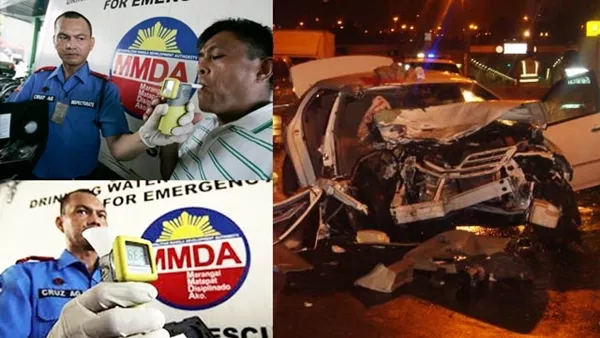The use of drugs is spreading like a fire in the Philippines. It is now one of the most concern problems in the country. Due to many reasons, drugs are often being used by ordinary people, poor ones, and even drivers of public utility vehicles. Drugged driving or DUID has now become one of the most common accidents on the road.
DUID stands for “driving under the influence of dangerous drugs” as well as other related substances. It discusses the act of driving or operating a vehicle while its driver is found guilty in using illegal drugs after being examined through a drug verification test as instructed under the law.

The drug test was conducted in line with the provisions of Republic Act 10586
Imagine you are riding on a public transport vehicle and the driver is using drugs, will you feel safe about it? No, your life could be at risk. Read on this article from Philkotse.com to better understand the cases and sanction of drugged driving.
Recently, there were many reports about drug-related activities in the country. According to PDEA Director-General Aaron Aquino, there are over 3,000 drivers, bus conductors as well as dispatchers who were arrested for violating the Republic Act 9165 or The Comprehensive Dangerous Drugs Act of 2002 from January 2018 to January 2019.
Moreover, there are 53 transport workers who are positive for using illegal drugs from the "Oplan: Huli Week". The purpose of the surprise drug test is the security of passengers who will travel in their respective provinces this Holy Week.
The results came from 7,729 transport workers, which the 53 positive workers are 35 bus drivers, 17 bus conductors, and 1 dispatcher. The drug test was conducted in line with the provisions of Republic Act 10586, in other words, Anti-Drunk and Drugged Driving Act of 2013.

PDEA Director-General Aaron Aquino said over 3,000 drivers were arrested for violating the Republic Act 916.
The Republic Act 10586 was full enforced because of the increasing number of road traffic accidents which are blamed on drivers who are using illegal drugs. Do you want to know more about this Republic Act 10586? If yes, you can refer below for some information about the Anti-Drunk and Drugged Driving Act of 2013.
1. What is Republic Act 10586?
It is an act penalizing persons who are driving under the influence of liquor, unsafe drugs, and similar elements. It also aims to inculcate to the drivers the standards of safe driving through official programs and other public information strategies.
What is the coverage of the law?
The law forbids driving when the driver is influenced by any alcohol such as beer and wine which causes intoxication when consumed. It also forbids a person operating a motor vehicle while influenced by drugs and the like. The motor vehicle applies to any transportation vehicle on land like trucks, buses, cars, and motorcycles.
Furthermore, the act also covers a huge variety of drugs including cannabis, cocaine, ecstasy, heroin, shabu, and ingredients on some prescription drugs like diazepam. It is not only illegal drugs which can cause you trouble.
If you want to know all drugs covered by this act, you can refer to the 1961 Single Convention on Narcotics Drugs and 1971 Single Convention of Psychotropic Substances.

The law forbids driving when the driver is influenced by any alcohol
>>> Read more: What to know about driving under the influence (DUI) & its sanctions.
When can a law enforcer officer stop a driver?
There should be a probable cause to conclude that a driver is driving within the effect of alcohol or any dangerous drugs before an enforcer can stop him/her. These “probable cause” includes over-speeding, swerving, lane straddling, sudden stops, weaving, the obvious smell of alcohol in your breath and the like.

“Probable cause” includes over-speeding, swerving, lane straddling, and/or sudden stops
2. What happens when a driver has been stopped and suspected of drugged driving?
There are three standardized tests that a driver will be subjected to when he/she has been stopped. These tests are the following:
Test 1: The Eye Test
The driver will be instructed to follow an object like a pen by his/her eyes. This test is used to find if there is an unwanted jerkiness of one’s eyes. Following the object through the eyes should be easily done by a normal individual. Meanwhile, if he/she shows irregularity in the eye movement, then the person is under the influence of alcohol or drugs.

The eye test is used to find if there is an unwanted jerkiness of one’s eyes
Test 2: The Walk-and-Turn
The driver will be asked to do a nine (9) steps heel-to-toe walk in a straight. After that he/she should turn and return to the initial point. The person should do this without having any difficulty.
Test 3: The One-Leg Stand
This test involves the driver and requires that he stand only with one leg with both arms on his side. It will be either his/her right leg or left leg. The other foot should be raised for about six inches above the ground for a duration of thirty (30) seconds.

The one-leg stand test involves the driver and requires that he stand only with one leg with both arms on his side
These three tests were adopted from the USA and are being widely used there. If the driver fails the three tests, the law implementation officer should check for his/her blood alcohol concentration level. The blood alcohol concentration or BAC level can be obtained by using a breath analyzer.
The driver only needs to blow in the breath analyzer. The disposable mouthpiece to be used by the driver should be new to avoid any error in the result and it is also not hygienic. The test results will be printed into three copies by the breath analyzer.
If it is then found that the driver is not drunk, he will be obliged to go under a drug confirmatory test and a confirmatory test if applicable. If the driver is positive in using drugs, he will be turnover to the closest police station while the driver will be arrested for other traffic offense if negative.
Moreover, a driver involved in a vehicle accident which resulted to a human injury or loss of life shall be required to the above tests, also ABA (Alcohol Breather Analyzer) testing and drug confirmation test and confirmatory test if applicable. It is done to determine any presence or blood alcohol concentration or any dangerous drugs and related substances in the body of the driver.
A law enforcement officer may use any other alcohol testing devices, like Gas Chromatography-Mass Spectroscopy (GCMS), if the use of a breather analyzer is not available under certain circumstances.
3. What after that?
What if the driver disagrees to undergo any of the tests?
If the driver does not want to undergo the standardized tests, his driver’s license will be confiscated and automatically revoked. The penalties provided by the act and any applicable laws will also be experienced by the driver.
What happens to the Driver’s License of those arrested?
The confiscated driver’s licenses confiscated will be turned over to LTO for safekeeping. It shall only be released by LTO after a lawful order from the court.
What are the penalties under R.A. 10586?
The arrested driver can be imprisoned. Specifically, there are designated penalties for both the owner and the driver of the motor vehicle involved in the crime.
4. What is the accountability of drivers?
A motorist found driving any vehicle while proven influenced by alcohol or drugs and similar substances shall be punished according to the following:
If the accident did not result in any physical injuries or death:
- A non-professional driver will be imprisoned for three (3) months, suspended the license for a year, and will be charged with a fine from Php 20,000 to Php 80,000.00 for the first time. If he/she is caught the second time, his/her license will be permanently revoked.
- A professional driver will have the same charges and additional of permanently revoked license for the first offense.
- The cancellation of a driver’s license means that the person can never apply or have a driver’s license in the Philippines again.

If the driver does not want to undergo the standardized tests, his driver’s license will be confiscated and automatically revoked
If the negligence caused physical injuries, the driver will be punished according to Article 263 of the Revised Penal Code and will be in charge of a fine between Php 100,000 to Php 200,000.
When the violation resulted in homicide or loss of human life, the driver will be penalized under Article 249 of the Revised Penal Code and will be facing a fine of Php 300,000 to Php 500,000.
>>> Check out: 7 most expensive fines for traffic violations in the Philippines (MMDA).
5. How about accountability of the operator and/or owners?
The owner and operator of the motor vehicle involved shall also be held responsible together with the delinquent. He will face the fine against the lawbreaker for public damages. The owner or operator will be exempted if he proves that a thorough selection and direction were applied to the drivers by her.

He will face the fine against the lawbreaker for public damages
This is applicable to owners and operators of any public or private vehicles such as trucks, buses, vans, cars, taxi, and many others.
Now you know about this Republic Act, it would be best to just simply drive safely and follow the road rules and regulations to avoid any trouble. It is truly not safe for a driver to be under the influence of either alcohol or illegal drugs.
We are not talking only about the life of the driver itself but also the lives of innocent people. Life of people is in their hands especially if we are talking about a public transport driver. If you don’t want to spend your life in prison, and at the same time save lives, do not drink or use illegal drugs and drive.
Recent posts
- Driving with injured person: 6 essential tips to follow Aug 16, 2022
- Top 10 bad behaviors that drivers should avoid while driving Mar 20, 2019
- Driving in the metro: 6 steps to avoid getting tickets for violations! Jan 26, 2021
- 6 things you should know about Anti Distracted Driving Act in the Philippines Feb 01, 2021
- 10 common mistakes drivers make while driving Dec 06, 2018












